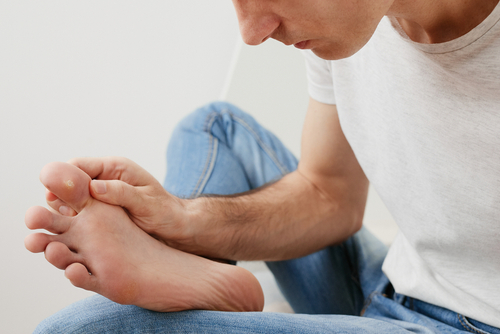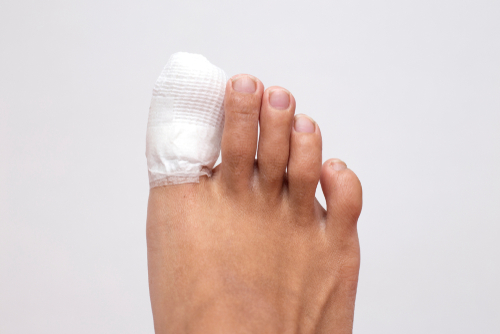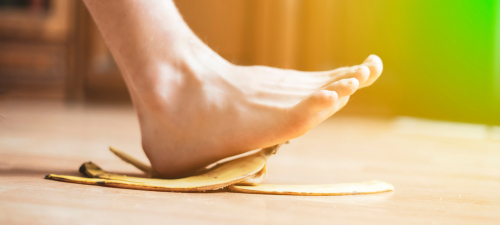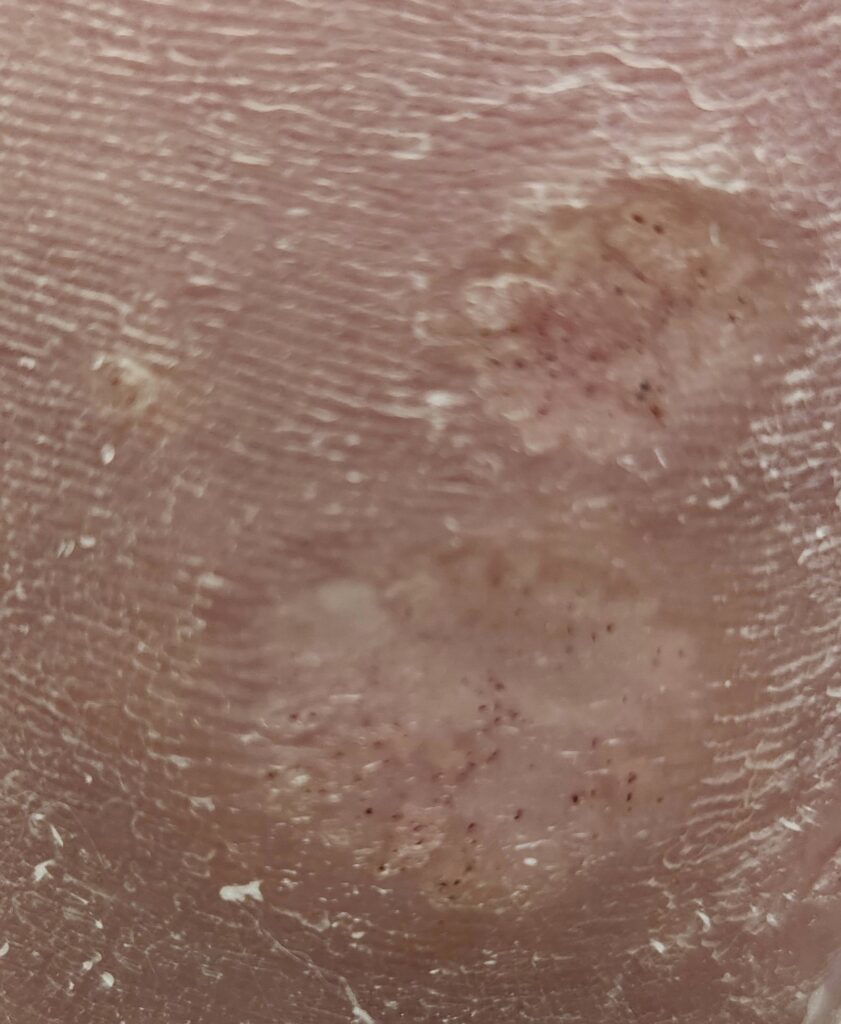
Our condition of the month for February is Verruca! Also known as plantar warts, verruca plantaris or verruca pedis, verrucae are caused by an infection of the top layers of skin by the human papilloma virus (HPV). There are over 100 varieties of HPV, some of which can cause more serious conditions such as cervical cancer. The few variants of HPV that can cause verrucae, however, are not the same as those that can cause cervical cancer and having them does not increase a person’s risk of developing more serious problems. Most HPV variants are in fact harmless.
Who is at risk?
HPV enters the body through cuts or breaks in the skin and thrives in warm, moist areas – such as your feet. Each person’s immune system responds differently to HPV. Not everyone who comes into contact with it develops warts. Even people in the same family react to the virus differently. The HPV virus that causes plantar warts is not very contagious, but you are more at risk of developing one if:
- You have a condition that affects the immune system or have a weakened immune system
- You are a child or adolescent
- You have had a previous plantar wart infection
- You use communal changing areas without protective footwear (verruca need moisture to survive and spread and, so, any wet surface such as in changing rooms with showers, poolsides or any wet surface where the bare feet of several individuals tread in the same place can be areas where verrucae can infect your feet)
Prevention
- Keep your feet clean and dry
- Wear protection on your feet, such as flip-flops, when using communal areas such as swimming pools or shared wet surfaces when barefoot
Signs and symptoms: Verrucae present as firm, small growths which are often found on high pressure areas, such as the heels or balls of the foot. You may be able to see some blackish / red dots on your skin, which are small, clotted blood vessels (capillaries). Verruca can be solitary or form clusters (mosaic warts) and can sometimes be painful and affect day-to-day life or sport as the hard skin builds up around them. Plantar warts are self-limiting and are generally not a serious health concern, however resolution can take time and for children this may take up to a year and for adults even longer.
Diagnosis: It may be obvious to you that you have a verruca but, if you are not sure, booking an appointment with a Podiatrist is a good place to start. Podiatrists can reduce the skin over the area and see more clearly how the area looks and, with some simple tests, will identify whether the issue is related to verrucae. Sometimes an instrument called a Dermatoscope can also be used to see the lesion more clearly and make the diagnosis.
Treatment
Self-management:
You don’t have to treat a verruca. If it is not painful, spreading rapidly or causing you concern, they can resolve of their own accord but this certainly takes longer in adults than children. It is not unknown for adults to have a verruca for more than 20 years! It is better to prevent spreading the virus though by:
- Wearing cotton socks as they are more breathable and may keep your feet cooler and dryer
- Avoiding scratching the area
- Always washing your hands thoroughly after touching the verruca
- Wearing footwear such as flip-flops in communal areas where you are barefoot
Home treatment can be started by:
- Using a file to reduce hard skin on the verruca and provide mild irritation which may help an immune response. When using a file, avoid using it on healthy, unaffected areas
- Covering the verruca with a plaster if you are worried about it spreading
- Over-the-counter treatments are available but evidence would suggest that the only worthwhile option is salicylic acid. Strengths of up to 40% salicylic acid are recommended for adults but it is advisable to start with lesser strengths for children and avoid using in children under the age of 2. Care should be taken not to get the preparation on healthy skin. Avoid using salicylic acid if Diabetic, have altered sensation or poor circulation in your feet or have problems with your immune system that may affect your ability to heal

When to see a Podiatrist
- If the growth is changing in appearance
- If non-prescription home treatments have not worked after 3 months
- If you are not sure what the growth is
- If the lesion is painful or is affecting how you walk, run and other daily activities
Treatments provided in clinic
We only offer verruca treatments that are currently based on good research evidence, but this is an ever-changing field. What research does continue to demonstrate is that verrucae are very resistant to any form of treatment at all! We believe the treatments below offer the best options currently and we review them regularly:
- Debridement – the top layer of skin is removed from the verruca using a scalpel. Verrucae are vascular so will often bleed when this is done, but this is not usually painful. This aims to stimulate the body’s immune response to recognise the virus and react. Reduction in the hard skin may also reduce the amount of discomfort you feel
- Salicylic acid application – this treatment works by reducing the hard skin on top of the verruca and helping to trigger an immune response to the virus. Most current research would suggest that this treatment is still one of the few that have an affect on verrucae. A stronger salicylic acid preparation will be applied in clinic and held in place with padding. This is kept in place and dry for 2-3 days before review in clinic in 2-3 weeks.
- Freezing (cryotherapy) – this involves applying liquid nitrogen to the verruca. This process may cause the skin to form a small blister, which results in a small area of local tissue being destroyed. This treatment can be a little uncomfortable for some people, so we will discuss with you if this treatment is appropriate for you. Similarly to salicylic acid, the treatment works by attempting to stimulate an immune response to the virus
- Verruca needling (Falknor’s needling) – this is a minor surgical procedure needing a local anaesthetic to numb the area where the verruca is. The appointment lasts for about one hour and you will not be able to drive yourself home (as your foot will be numb!). During the procedure a sterile needle is used to repeatedly puncture the verruca. This is a more invasive procedure, breaking down the verruca at a deeper level to initiate an immune response. No pain is felt during the needling and, after the first 24 hours, normal activity can be resumed unless the foot is too sensitive. There is some evidence to suggest that needling is more effective in very difficult to treat verruca after the first treatment, with even more efficacy after the second treatment if needed. It is usually necessary to attend the clinic for a review appointment 4 weeks after the needling procedure to check the response to treatment
Other treatments

Other treatments, including applying duct tape and banana peel (!), have been investigated and found to either not be effective, have more risk than benefit or have poor research evidence to date. Microwave therapy has shown promise but with no compelling published evidence, this is one that we are watching for the future.
What to do next if you have a verruca?
As we describe, your verruca is not harmful, but can spread on your own skin and onto the skin of others so the best advice is to try to prevent this happening. If you are otherwise well and have no problems with your immune system, there is a good chance that the verruca will resolve on its own but longer-standing verrucae are less likely to do this, especially in adults. If you have already tried treatments at home and it is no better then it is certainly worthwhile trying one of the treatments mentioned to help resolve this issue.
More questions about verruca? Please contact us or book here if you would like to make an appointment.
Coming up in the Condition of the Month for March – Ingrowing Toenails!

